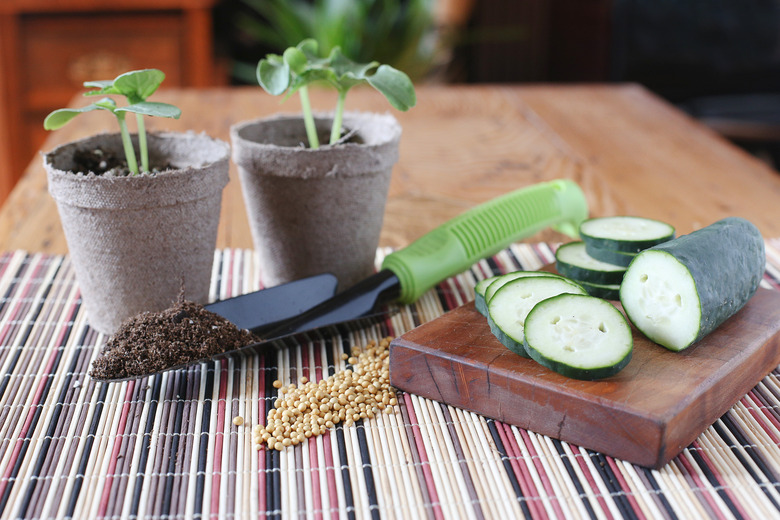How To Grow Cucumbers With Tomato Cages
Vine-variety cucumbers (Cucumis sativus), need a lot of space to spread out, so you can grow cucumbers with tomato cages to help keep the vines under control. Using tomato cages to train cucumbers for vertical growth gives the plants lots of breathing room, aids in the formation of perfectly straight fruits and helps keep pests and soil-borne diseases at bay. When space for a vegetable garden is at a premium, training cucumbers vertically can also free up a great deal of garden real estate.
Test the Soil's pH
Test the Soil's pH
Cucumbers favor well-draining, slightly acidic soil with a pH level of 5.8 to 6.5. Have the soil tested to determine its exact pH level and follow the the testing laboratory's recommendations regarding the application of amendments to correct the soil's pH. Incorporate 1 to 2 inches of organic matter such as compost into the soil to create a nutrient-rich base for the new plants. Add a pre-planting application of a 5-10-10 fertilizer if the soil hasn't been tested to determine nutritional needs.
Start the Seeds Outdoors
Start the Seeds Outdoors
Cucumbers are tender annual vegetables that refuse to germinate in cold soil and thrive in temperatures ranging from 75 to 85 degrees Fahrenheit. For best results, start cucumber seeds directly outdoors after all chance of frost has passed and the soil reaches 70 F at a depth of at least 1 inch.
Plan for an Early Harvest
Plan for an Early Harvest
For an early harvest, start cucumber seeds indoors two to four weeks before the last expected frost date. Sow two to three seeds in peat pots or pellets and thin to one seedling in each pot after sprouting. Transplant the seedlings to the outdoor planting site when all chance of frost has passed, soil temperature measures 70 F, and the seedlings have developed three to four sets of true leaves. Plant established seedlings at least 10 to 12 inches apart beneath tomato cages.
Contain Cucumbers With Tomato Cages
Contain Cucumbers With Tomato Cages
To grow cucumbers in tomato cages, you need stable supports. Choose sturdily constructed tomato cages, at least 3 to 4 feet tall, that won't be easily rattled by a stiff breeze or the weight of the developing cucumbers. Insert the cages into the soil directly above the planting location and then sow 1 to 2 cucumber seeds inside each cage, at a depth of 1/2 to 1 inch, spaced approximately 4 to 6 inches apart.
Once the vines begin to grow, nudge them toward the sides of the cages where their grabby tendrils can attach to the cage wires as they begin growing in an upright fashion. As the vines lengthen, they can be secured to the cages with loosely tied twine until they reach the top of the cage and start to hang down.
Provide Consistent Moisture
Provide Consistent Moisture
Cucumbers require consistent moisture during the growing season and especially when the blooms appear and fruits begin to set. When cucumbers are water-stressed, fruits can become misshapen and develop an unpleasant bitter flavor.
Water cucumbers at least once per week, making sure to moisten the soil to a depth of at least 6 inches. If the soil is sandy, additional watering will be required to keep the soil adequately hydrated. To help with moisture retention throughout the season, add a 1- to 2-inch layer of organic mulch over the planting location.
Apply Nitrogen Fertilizer
Apply Nitrogen Fertilizer
Cucumbers, which are moderate feeders, need a dose of nitrogen fertilizer when the plants start to vine and about a week after blooms first appear. Add 1/2 cup of a 46-0-0 fertilizer for every 25 feet of planting space. Apply the fertilizer along the side of the row and approximately 4 to 6 inches from each plant. Additional fertilizer may not be necessary if the soil is enriched with organic compost.
